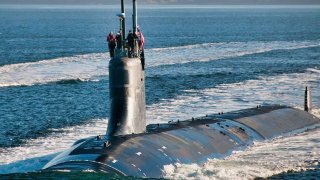The Navy's Seawolf-class Submarine Nightmare Could’ve Been Avoided
The Seawolf-class submarine, the pinnacle of U.S. naval stealth and surveillance technology, remains an unfulfilled potential due to limited production.
Summary and What You Need to Know: The Seawolf-class submarine, the pinnacle of U.S. naval stealth and surveillance technology, remains an unfulfilled potential due to limited production.
-Originally intended to replace the Los Angeles-class fleet, only three Seawolf submarines were completed following post-Cold War budget cuts. With groundbreaking features, such as modular designs, advanced acoustic cladding, and Arctic operation capabilities, the Seawolf-class could have bolstered the Navy’s strategic edge, especially against rising near-peer threats from China and Russia.
-Despite its unmatched abilities in intelligence and Arctic readiness, the limited fleet size prevents Seawolf-class submarines from fulfilling their intended role as a game-changer in modern naval warfare.
Could the Seawolf-Class Have Secured U.S. Naval Superiority?
America possesses some of the most advanced submarines in the world. From the Los Angeles-class attack submarine to the Ohio-class ballistic missile nuclear-powered submarine, the United States Navy has built a truly fearsome arsenal of undersea platforms. But the most advanced—indeed, the best—may be the Seawolf-class attack submarine.
First ordered by the Navy from the Electric Boat Division of General Dynamics in Connecticut in 1989, the USS Seawolf was commissioned in July 1997. A year later, the USS Connecticut was commissioned, and the third ship, USS Jimmy Carter, was launched in 2005. That submarine was given an improved payload and underwater maneuverability. These submarines were initially intended to replace the ubiquitous Los Angeles-class attack submarines.
Bad Political Decisions
But with the end of the Cold War came several changes to America’s defense posture. Notably, the United States Congress did not want to fund the military the way that it had been funding it throughout the Cold War. The Soviet Union was gone. There were no significant near-peer competitors to the United States at that time. So, the logic went, Washington could afford to downsize its force. The Navy originally planned to have 29 of these incredible submarines at the ready.
They got three. And, for a period of time after the USS Connecticut (according to official reports) accidentally smashed into an underwater mountain (or, “seamount”), the Navy had just two of these incredible platforms at their disposal.
Some Interesting Enhancements
When the Navy purchased the Seawolf-class it was because the Pentagon needed to fill a need for stealth. The Soviet Navy, despite the fact that the USSR itself was in freefall, had at its disposal several systems that were catching up to the advantages the US Navy had in terms of undersea platforms. The Seawolf-class was meant to enhance America’s acoustic advantages over Soviet subs. Beyond its enhanced silence, the Seawolf-class had several other innovations that has made it a true legend.
The Seawolf-class had modification to the ballast control, mission management spaces, and an incredible “wasp waist” capability that enabled “the deployment and recovery of payloads without the use of torpedo tubes,” according to the defense industry site Naval-Technology.com. Further, Seawolf-class submarines were given “high-capacity communications mast and remotely operated vehicle (ROV) handling system.”
In fact, the Seawolf-class is the world’s leading spy submarine. These boats are used to engage in complex—and dangerous—electronic surveillance missions globally. Moreover, the design of these submarines was innovative and has since been used in subsequent US Navy submarine designs. For instance, these subs were designed to make room for inevitable upgrades, making them a worthwhile investment in the long term. And the modular design also allowed for a more efficient use of limited space onboard.
The Capabilities
A Seawolf-class submarine has a submerged displacement of 9,137 tons when undersea and 8,060 tons when surfaced. They now have full acoustic cladding. And they are fast boats, reaching upwards of 35 miles per hour.
These boats carry 116 personnel, including 15 officers. Seawolf-class submarines have a diving depth of 610 meters and can operate at a “sub-ice” level thanks to retractable bow planes.
Indeed, these subs are meant for Arctic warfare and surveillance operations—which may become more routine in coming years, as Russia (and China) enhance their positions in the Arctic relative to that of America’s.
A Missed Opportunity
But the Seawolf-class submarine is an incredibly capable platform whose true potential, sadly, was never fully realized. With just three boats, these submarines will never be the key difference-maker in combat with near-peer adversaries they were intended to be. The US government’s decision to not build all 29 submarines of this class is one of the most short-sighted decisions ever made.
It will have negative strategic consequences, as a near-peer conflict is at hand.
Had the Navy built all 29 submarines of this class, America would have unprecedented offensive capabilities that would have likely ameliorated whatever advantages China (and their allies) possess over the US Navy’s surface warship fleet with the advent of anti-access/area-denial (A2/AD) systems.
About the Author
Brandon J. Weichert, a National Interest national security analyst, is a former Congressional staffer and geopolitical analyst who is a contributor at The Washington Times, the Asia Times, and The-Pipeline. He is the author of Winning Space: How America Remains a Superpower, Biohacked: China’s Race to Control Life, and The Shadow War: Iran’s Quest for Supremacy. His next book, A Disaster of Our Own Making: How the West Lost Ukraine, is due October 22 from Encounter Books. Weichert can be followed via Twitter @WeTheBrandon.
Image Credit: Creative Commons and/or Shutterstock.
From the Vault
Russia Freaked Out: Why the U.S. Navy 'Unretired' the Iowa-Class Battleships
Battleship vs. Battlecruiser: Iowa-Class vs. Russia's Kirov-Class (Who Wins?)


